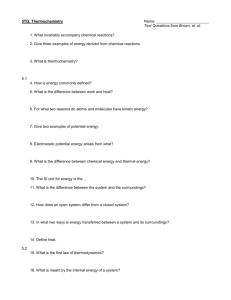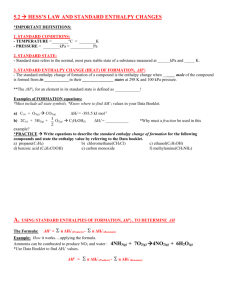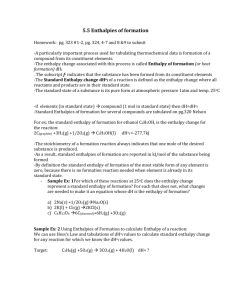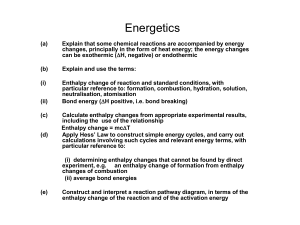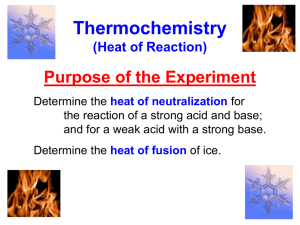Chapter 5 Class Notes
advertisement
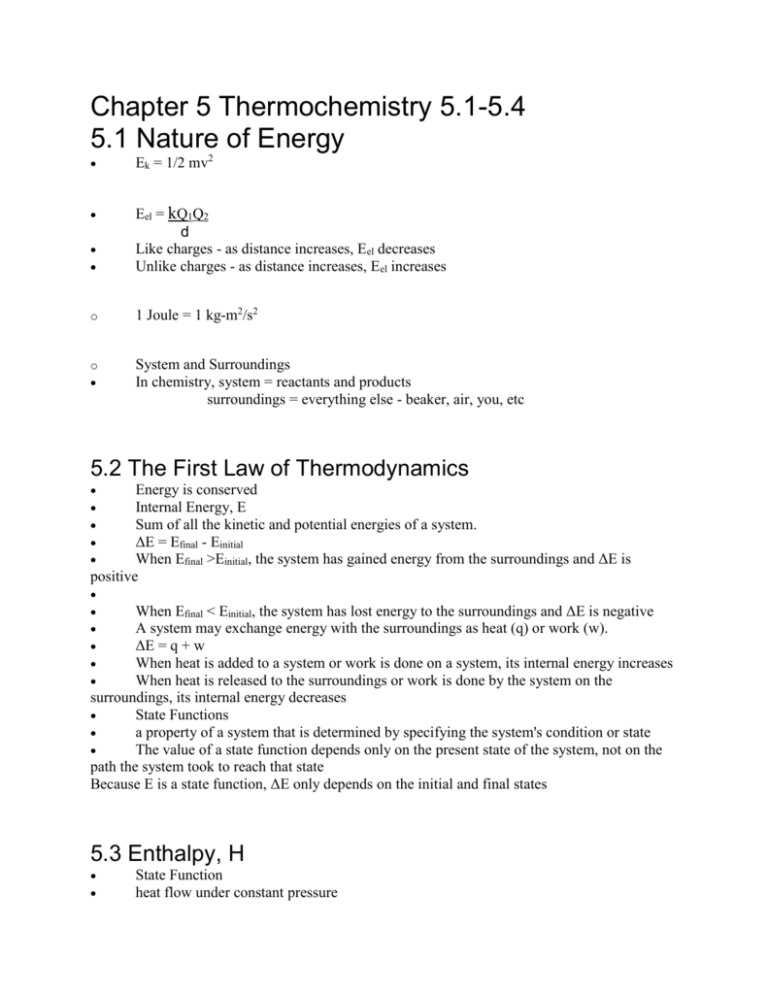
Chapter 5 Thermochemistry 5.1-5.4 5.1 Nature of Energy Ek = 1/2 mv2 Eel = kQ1Q2 d Like charges - as distance increases, Eel decreases Unlike charges - as distance increases, Eel increases o 1 Joule = 1 kg-m2/s2 o System and Surroundings In chemistry, system = reactants and products surroundings = everything else - beaker, air, you, etc 5.2 The First Law of Thermodynamics Energy is conserved Internal Energy, E Sum of all the kinetic and potential energies of a system. ΔE = Efinal - Einitial When Efinal >Einitial, the system has gained energy from the surroundings and ΔE is positive When Efinal < Einitial, the system has lost energy to the surroundings and ΔE is negative A system may exchange energy with the surroundings as heat (q) or work (w). ΔE = q + w When heat is added to a system or work is done on a system, its internal energy increases When heat is released to the surroundings or work is done by the system on the surroundings, its internal energy decreases State Functions a property of a system that is determined by specifying the system's condition or state The value of a state function depends only on the present state of the system, not on the path the system took to reach that state Because E is a state function, ΔE only depends on the initial and final states 5.3 Enthalpy, H State Function heat flow under constant pressure H = E + PV ΔH = ΔE + PΔV = (qp + w) - w = qp the change in enthalpy equals the heat gained or lost at constant pressure When ΔH is positive, the system has gained heat from the surroundings (endothermic) When ΔH is negative, the system has released heat to the surroundings (exothermic) 5.4 Enthalpies of Reactions Because enthalpy is a state function, it depends only on its initial and final states In a chemical reaction, ΔH = Hproducts - Hreactants This is called the enthalpy or heat of reaction (ΔHrxn) 2H2(g) + O2(g) 2 H2O(g) Thermochemical Equation ΔH = -483.6 kJ Guidelines for thermochemical equations Enthalpy is an extensive property The enthalpy change for a reaction is equal in magnitude but opposite in sign to ΔH of the reverse reaction The enthalpy change for a reaction depends on the states of the reactants and products. 5.5 Calorimetry Calorimetry The measurement of heat flow Use a calorimeter Heat capacity, C The amount of heat required to raise the temperature of a substance by 1K or 1C molar heat capacity is the heat capacity of one mole of a substance specific heat is the heat capacity of one gram of a substance Cs = q m x ΔT q = Cs x m x ΔT Constant pressure Calorimetry coffee cup calorimeter heat gained or lost by the solution is equal in magnitude but opposite in sign to heat absorbed or released by reaction qsoln = Cs x msoln x ΔT = -qrxn Bomb Calorimetry used with combustion reactions substance is in small cup within an insulated sealed vessel called bomb Combustion reaction is initiated and the heat released is absorbed by the water. qrxn = -Ccal x ΔT Practice: When a 6.50-g sample of solid sodium hydroxide dissolves in 100.0 g of water in a coffee-cup calorimeter, the temperature rises from 21.6°C to 37.8°C. Calculate ΔH (in kJ/mol NaOH) for the solution process NaOH(s) Na+(aq) + OH-(aq) Assume that the specific heat of the solution is the same as that of pure water. Practice: A 2.200-g sample of quinone (C6H4O2) is burned in a bomb calorimeter whose total heat capacity is 7.854 kJ/C. The temperature of the calorimeter increases from 23.44°C to 30.57°C. What is the heat of combustion per gram of quinone? Per mole of quinone? 5.6 Hess's Law If a reaction is carried out in a series of steps, ΔH for the overall reaction equals the sum of the the enthalpy changes for the individual steps. used to calculate energy changes that are difficult to measure directly. Example: It is impossible to directly calculate the enthalpy for the combustion of C to CO. However, the following two thermodynamic equations are known: 1) C(s) + O2(g) CO2(g) ΔH = -393.5 kJ 2) CO(g) + 1/2 O2(g) CO2(g) ΔH = -283.0 KJ Using these data, calculate the enthalpy for the combustion of C to CO: 3) C(S) + 1/2 O2(g) CO(g) ΔH = _________ From the enthalpies of reaction: H2(g) + F2(g) 2HF(g) ΔH = -537 kJ C(s) + 2F2(g) CF4(g) ΔH = -680 kJ 2C(s) + 2H2(g) C2H4(g) ΔH = +52.3 kJ calculate the ΔH for the reaction of ethylene with F2: C2H4(g) + 6F2(g) 2CF4(g) + 4HF(g) ΔH = ______ 5.7 Enthalpies of Formation, ΔHf the enthalpy change that occurs when a substance is formed from its constituent elements Standard enthalpy of formation of a compound is the cahnge in enthalpy for the reaction that forms one mole of the compound from its elements with all substances in their standard states, ΔHf. Example: C(s) + H2(g) + O2(g) C6H12O6(s) ΔHf= -1273 kJ/mol The standard enthalpy of formation of the most stable form of any element is zero because there is no formation reaction needed when the element is in its standard state. Enthalpies of formation can be used to calculate the enthalpy of a reaction ΔHrxn = ∑nΔHf(products) - ∑mΔHf(reactants) Calculate the standard enthalpy of reaction for CaCO3(s) CaO(s) + CO2(g) ΔHrxn = ΔHf[CaO(s)] + ΔHf[CO2(g)] - ΔHf[CaCO3(s)] = -635.5 kJ + (-393.5 kJ) - (-1207.1 kJ) = 178.1 kJ 5.8 Foods and Fuels o Foods Energy is stored in our bodies as carbohydrates, fats, and protein Carbohydrates average fuel value of 17 kJ/g (4 kcal/g) break down quickly body stores a very small amount water-soluble produce CO2(g) and H2O(l) when metabolized Fats average fuel value of 38 kJ/g (9 kcal/mol) serve as the body's energy reserve insoluble in water produce CO2(g) and H2O(l) when metabolized Proteins averge fuel value of 17 kJ/g (4 kcal/g) used mainly by the body as building material for skin, muscles, etc produces N2 which ends up mainly as urea, (NH2)2CO. Fuels During combustion of fuels, carbon is converted to CO2 and hydrogen is converted to H2O. These have large negative enthalpies of formation. The greater the percentage of C and H in a fuel, the higher its fule value. Fossil Fuels Natural gas primarily methane, CH4, with small amounts of ethane, C2H6, propane, C3H8, and butane, C4H10. Petroleum composed of hundreds of compounds, most being hydrocarbons Coal solid, made up of hydrocarbons, as well as compounds containing sulfur, oxygen or nitrogen most abundant fossil fuel when combusted, it releases SO2, which is a component of acid rain Other Energy Sources Nuclear Energy splitting of atomic nuclei 21% of US electrical power (8.5% of total US energy production) Renewable energy sources solar, wind, geothermal, hydroelectric, and biomass energy currently 7.4% of US energy consumption



